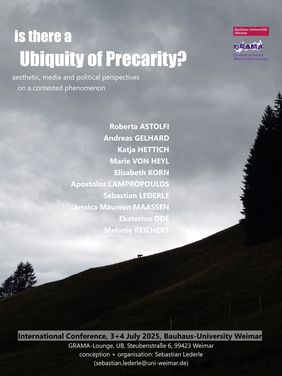International Conference: Is there a Ubiquity of Precarity?
Media, aesthetic and political perspectives on a contested phenomenon
International Conference at the Bauhaus-University Weimar
Grama-Lounge
University Library (Steubenstraße 6, 99423 Weimar)
3-4. July 2025
The workshop departs from the assumption that precariousness is first experienced by those who are placed under uncertain, media, political and aesthetic conditions of becoming a subject and relating to the world as a world of becoming. The question of what it means to live in a world in which precarity has become ubiquitous cannot be answered without considering its medial, infrastructural forms of presentation and its modes of appearance, which are tangibly reflected in the field of aesthetics and make it appear as being contested in itself – and thus political. There is no demarcation between the medial, the aesthetic and the political that is not open to negotiation, contingent and contested. What it means to be precarious is challenged by other perspectives on it, so that one’s own perspective on precarity is always already called into question and lacking standards and last foundations to refer to in order to answer the question what it means to be and call something or someone precarious.
What can be termed the aesthetics of the precarious becomes evident not least with regard to the question of the extent to which aesthetic practices, techniques and the associated processes of attribution and evaluation not only thematically engage with precarity, but have also become precarious in an operative sense: How can knowledge of the aesthetic – in contrast to the medial and the political – be justified, if the previous criteria, standards and routines themselves exhibit a precarious status and must be repeatedly renegotiated? Can aesthetic knowledge only be asserted and maintained if it already proves to be permeated or marked by mediality and the political, that is, only has something to say if it keeps an eye on its own precarity as the precarity of the others (and vice versa)? Isn’t this exactly the point being made by saying the political is already at play and incorporated in aesthetic practices and experiences, because it blures the lines from within the realm of aesthetics? Doesn’t this also mean, that the relation of aesthetics and the political point at the way media operate? Media are the agents, milieus and operations by which aesthetics and the political call each other into question and contest each others. Media allow to contest the meaning of precarity, its attribution and how it informs structures as well as subjects in the first place, because they are already in play and doing their work, when someone or something becomes precarious. Media collaborate in making precarity and being made precarious.
Connected to this is the question of what role the arts (or the knowledge of the arts) play in how precarity is re-presented, and who is considered and perceived as precarious. Not least, what it means to be precarious, to whom one is to be counted as precarious, and to be able to articulate one's own precarity at all as such, is itself contested in a non-trivial sense. Is there a potentia precaria or does the conditio precaria consist precisely in the fact that it is only indirectly noticeable in its effects and in what and whom it destabilizes and undermines? If this is the case, however, it must be considered how it can be grasped and put onto display at all. This would then be a question of the specific mediality and aesthetics of the precarious: One is never just precarious and insists on it, as it were – and yet precariousness lacks direct visibility, in which it manifests itself directly and tangibly when normalized frames of reference fail.
In that sense precarity goes beyond a mere social and political category, in that it also concerns the foundations of the human relationship to the self and the world. The point of a media-philosophical and aesthetic concept of precarity therefore lies in not only localizing the contingency and the interminable contestability of ascribed statuses in the theories of the political, but also in expanding them in a media-materialistic and aesthetic way. Precarity is, according to the working hypothesis of the workshop, the current modus operandi of the aesthetic. It is no longer possible to speak about precarity independently of who and what is positioned by it, how and in what respect from a medial and aesthetic perspective. Precarity is something that affects insofar it is seen as an effect, which has no origin or foundation, since it is the fact of distorting and eluding solid claims of knowledge, aesthetic phenomenality and political attributions of belonging. Media are the way this intertwinement comes into view as such.
Curated and organized by Sebastian Lederle (sebastian.lederle[at]uni-weimar.de)

